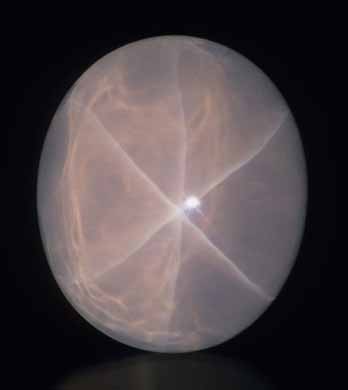 E. Skalwold Collection Photo: Jeff Scovil |
and Asterism Revisted | ||
| Previously unknown, the fibers are related to dumortierite and at 100-500 nm in diameter they are so small that it would take hundreds of them together to approach the thickness of a human hair. Features this small can only be imaged using a scanning electron microscope (SEM) and it was only relatively recently that their true significance became known, notably through the research of Dr. George Rossman and his graduate students, Chi Ma and Julia S. Goreva of Caltech. The cause of color in rose quartz has been debated over the years attributing it even in current texts variously to manganese, titanium, intervalence charge transfer (IVCT) between iron and titanium and to Tyndall scattering by rutile inclusions. The star effect (asterism) itself has been attributed to the rutile needles as well. |
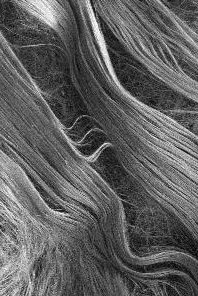 extracted from rose quartz. Photo courtesy of George Rossman | ||
| 1n 1987, the dumortierite-like fibers were reported by Applin and Hicks in rose quartz from the Ruby Range in Montana. Following up on this report, the Caltech team studied samples from deposits around the world, isolating the same mineral in each and quantifying its unique nature with its role in producing both the rose coloration and the asterism. Interestingly, the rose color of the fibers themselves is due to a Fe-Ti IVCT. | |||
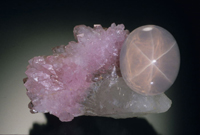 Click to Enlarge Single crystal pink quartz and star rose quartz. |
Rose quartz is a massive variety of quartz found worldwide in pegmatite and hydrothermal deposits. Pink quartz is a rare single crystal variety colored by radiation induced electron hole centers involving Al - P substitutions; it does not form stars. Within the massive material there are regions of single crystals which can span many centimeters (Rossman personal comm, 2008). Hense, despite its aggregate nature, the regional crystal symmetry environment allows the formation of a six ray star seen here. The quartz three-fold symmetry dictates the lining up of fibers in a plane perpendicular to its vertical c-axis and relative to the three lateral axes which are at 120 degree angles to each other. | ||
Asterism and the Crystal Structure "The focus of a star stone is not on or in the star, but above the surface - see article in Journal of Gemmology by Harold Killingback: 'Stereoscopic effect in asterism and chatoyancy' Jan/April 2005 Vol 29 No 5/6 (Alan Hodgkinson, personal communication, 2006 edit) and paper by Würthrich. Asterism is not only seen with overhead point-source light such as from a flashlight or the sun itself, the phenomenon can also be seen in transmitted light, that is, by shining a light through the mineral from behind as seen with mica in the image below (often referred to as diasterism). Each one of the chatoyant bands results from the interaction of light with microscopic inclusions oriented at right angles to the band itself. 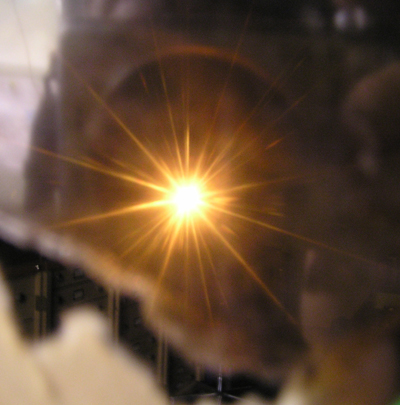 The view through a transparent, bronzy colored cleavage sheet of phlogopite mica. A multitude of oriented microscopic needles scatters the light, producing a spectacular star. Photo: E.Skalwold | |||
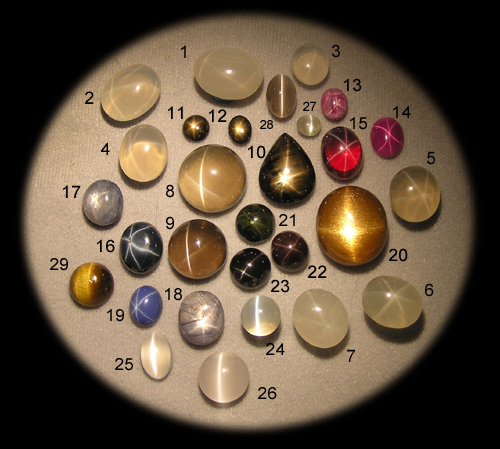 Star and Cat's Eye Stones Photo: E.Skalwold | |||
| |||
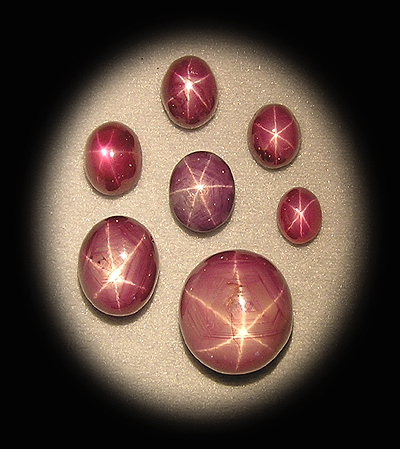 With the exception of the center stone, all are lead glass filled. Photo: E.Skalwold | |||
| With their visible inclusions and growth zoning, as well as large literature base of scientific investigation, star sapphires offer a perfect model with which to study asterism or multiple chatoyancy. In the above ruby cabochons, the crystal symmetry of the corundum is clearly visible, while in other chatoyant gems this may not be the case, as in the quartz stars seen below. Never-the-less, even if not readily apparent to the eye, the underlying crystal structure of the host material and its interaction with the crystal structure of inclusions which have formed by exsolution within, leads to the formation of star and cat's eye effects in gems cut en cabochon (also of that in rarely seen concave cuts). | |||
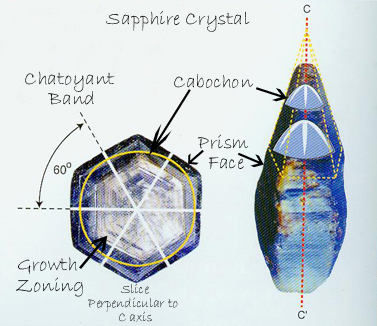 A distorted bi-pyramidal star sapphire crystal from Kyauk-pyat-that, Mogok, properly oriented for cutting into star stones. Image courtesy of Ted Themelis, adapted (with permission) from his book, "Mogok - Valley of Rubies & Sapphires" | |||
| The three criss-crossing chatoyant bands seen in these star rubies form perpendicular to the layout of inclusions commonly referred to as silk. In this case rutile needles line up parallel to the crystal's prism faces and within a plane parallel to the basal pinacoid - that is, in a plane perpendicular to the c axis. Even in the stones pictured which have some very minimal lead glass filled of fractures (originating from the very early days of this treatment technique), in proper light the arms of the stars are very sharp, straight and complete. Note: if the planes of inclusions are very tightly packed and the stone is cut with its base parallel to the c axis, a cat's eye sapphire is possible, though rarely done in favor of more valuable star stones (Hughes, 1990). According to Dr. Schmetzer this chatoyancy (as seen in Mogok sapphires) is "caused by internal total reflection of two sectors of crystals inclined to each other at 11 degrees" (Themelis, 2008). | |||
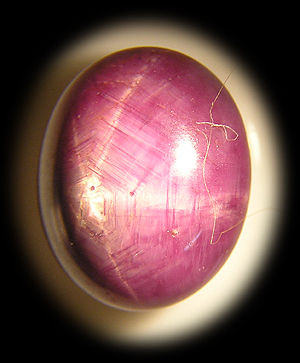 and yes, that piece of fuzz is on the ruby, not your monitor. With placement of the fiberoptic light, the star is purposefully centered on the hexagon (which was not in the center of this cab). Photo: E.Skalwold | |||
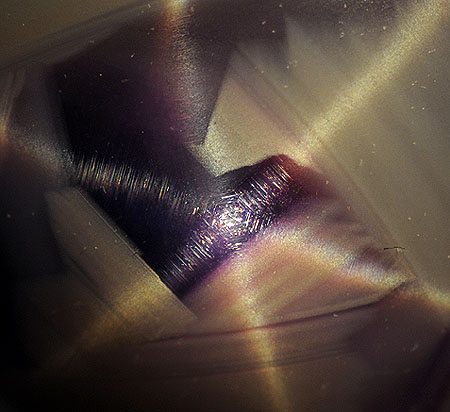 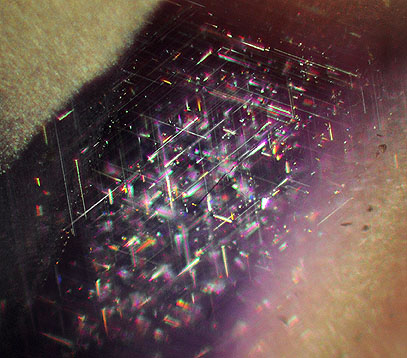 Photo: E.Skalwold | |||
| Rutile, the tetragonal crystal form of titanium oxide, is one of the most common inclusions of corundum. This is not surprising for titanium is nearly always present in the growth environment and is found throughout the corundum itself, though more so in some types than others. At temperatures of 1200-1400 C, titanium moves through the resulting expanded crystal lattice and between the oxygen atoms, exsolving into elongated needle shaped rutile crystals. The geometry of the corundum lattice (expressed also in the visible symmetry of the crystal) governs the orientation of these needles by controlling how the titanium is able to migrate through it and subsequent rutile crystal formation (Bariand, 1985). These tetragonal crystals are forced to arrange their prism faces parallel with their host's basal plane and with their body diagonals parallel to the second order prism face of the corundum. The chemical geometry of oxygen in rutile crystals and in that of corundum is highly compatible: the distance between the ions along the c-axis of the rutile corresponds to the distance between the ions of corundum parallel to its horizontal axes. An orchestrated series of factors in combination compel the ions of the precipitating rutile to alternate with that of the corundum thus determining their characteristic orientation (Bariand, 1985; Gübelin, 1953, Gübelin, 2004). | |||
 A window into a sapphire crystal showing its trigonal crystal symmetry; colorless silky center with nearly opaque blue outer growth. Photo: E.Skalwold | |||
| In diffused star corundums the rutile needles tend to be submicroscopic which, along with the orientation of the rays, help to differentiate induced asterism from naturally occurring stars comprised of larger rutile needles. These diffused stars are produced in natural and synthetic sapphires by a two step process: first the fashioned cabochons are heated in a mixture of aluminum oxide and titanium oxide to a temperature of 1700-1950 C, allowing the titanium to diffuse into a thin surface layer. Next the cabochon is heated again, this time to 1100-1500 C which induces the formation of rutile needles sufficient to create the star effect. While cloudy, silky natural corundum is often heated above 1550 C to clarify it and improve color; heating transparent non-asteriated sapphires or those with poorly developed stars to a lower temperature can cause rutile to crystallize out if there is sufficient titanium present, thus forming or improving asterism in certain sapphires (Schmetzer, 2003). | 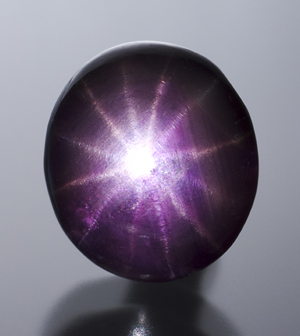 Source: Bassett, W. A. and Skalwold, E.A. (2012) The Edward Arthur Metzger Gem Collection. Herbert F. Johnson Museum of Art, Cornell University, Ithaca. 415 pages. Photo: Jeff Scovil, used with permission |
||
| Stars in corundum may also form from silk comprised of ilmenite and/or hematite, as can be seen in 6-12-ray black star sapphires of Australia and Thailand. As with the color banding in corundum, rutile needles lie parallel to the second-order prism faces. Hematite exsolves parallel to the first-order prism faces and so can be seen perpendicular to the the color zoning, a photomicrograph of which appears on page 414 in Volume 1 of the PhotoAtlas (Gübelin, 2004). The strong 6-ray black star sapphires from the Thai province of Chanthaburi in which hematite may be responsible for the chatoyancy will also sometimes show a weaker 6-ray star due to rutile; in high enough concentrations this will give rise to a strong 12-ray sapphire (Hughes, 1990). | Note how the rays behave as the sapphire is turned in the light. |
||
| While the sheer concentration of hematite gives Bang Ka Cha black sapphire its apparent color, the underlying color of the corundum itself affects the color of its rays; a blue or green sapphire gives rise to a white star and a yellow body color gives rise to a golden star, both on black backgrounds - though very occasionally 6 rays are golden while the remaining rays are white (Hughes, 1990; Hughes, 1997; Webster, 1994; Koivula; 2004). The three bands are at 120 degrees to each other forming 60 degree angles between each of the 6 rays. The second-order prism faces are 30 degrees off of the first-order prism faces; thus in a 12-ray sapphire,the rays will form 30 degree angles. | 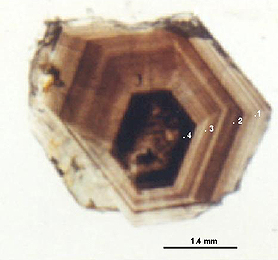 The needles are concentrated in layers and in the core. Photo courtesy of Dr. Seriwat Saminpanya and used here with permission. |
||
| With all that said, while R.W. Hughes and others contend that hematite and rutile are responsible for asterism in Thai black star sapphires, Dr. Seriwat Saminpanya of Srinakharinwirot University, Bangkok has conducted an in-depth study of these fascinating phenomenal gems from his homeland and offers an alternate view. | |||
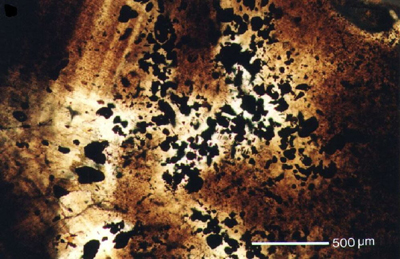 The needles have accumulated along the hexagonal growth zoning of the sapphire, with orientations perpendicular to the sapphire's first order hexagonal prism faces {10-10}. (Viewed parallel to the to the basal pinacoid {0001} in transmitted light with PPL.) Photo courtesy of Dr. Seriwat Saminpanya and used here with permission. | |||
| By employing an electron probe microanalysis - wavelength dispersive spectrometer (EPMA-WDS), Dr. Seriwat investigated the iron and titanium content of black star sapphires from Bang Kacha (Bang Ka Cha). What he found was evidence suggesting that the needles contain both iron and titanium and may represent "a solid solution mineral of the ilmenite-hemitite series, ilmenite, or a spinel" rather than a pure rutile or hematite. Black platelets of magnetite-hercynite were also observed in association with the needles and are typical inclusions found in growth-banded sapphires of basalt origin. The largest and most numerous black stars come from Bang Kacha, but are also mined in Bo Phloi, Den Chai and Nam Yun (for more information, see Saminpanya, 2001). | |||
 Black star sapphires from Bang Ka Cha, Thailand. The 22.89 ct center stone exhibits 12 rays. Photo: E.Skalwold | |||
| Both quartz and corundum are in the trigonal crystal system and at least some of the same concepts outlined above for corundum may be generally applied to the study of chatoyant quartz. Other symmetry governs alignment of inclusions in several chatoyant gems such as beryl, zircon, garnet and feldspar, as well as various other minerals. | |||
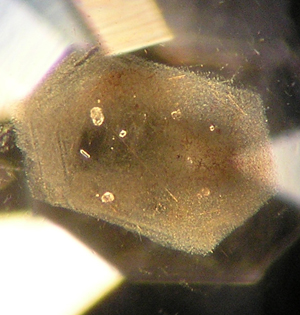 A faceted green sapphire with a suite of oriented inclusions reflecting its crystal symmetry. The cutter positioned this just under the table...presumably he thought it as neat as I do. Photo: E.Skalwold | |||
My fascination lies with studying the multi-star networks found in quartz, garnet, and beryls such as aquamarine and emerald. In the Sri Lankan quartz cabochons below, sub-microscopic sillimanite needles were identified by Dr. Gübelin as the cause of the stars in the network. Later Woensdregt, et al. (1980) determined the sillimanite needles to be approximently 20 nm wide and oriented thus: "...parallel to the {0001} plane of quartz in three sets which interesect at a 60 degree angle....In the {001} plane, the {001} direction of sillimanite is parallel to the {100} direction of quartz." (revise) These multi-star quartz were studied extensively by Dr. Gübelin and later by Dr. Karl Schmetzer and others (see references below). | |||
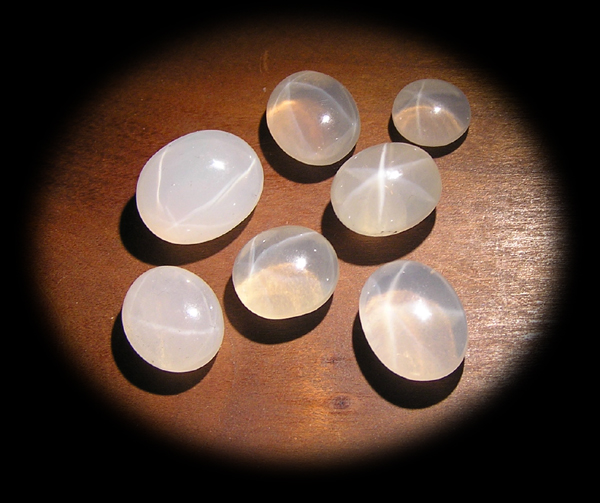 Though very difficult to capture several stars at once in an image, still visible are several 6 and 4 ray stars all on the same cabochon. Others become evident by rolling the stone around under a strong point source light or in the sun. For a better image, see: Star Quartz. Photo: E.Skalwold | |||
At 90 degrees to the c axis - the "equator" - of a multi-star quartz sphere, there are six 6- ray stars possible in a simple situation. Between these on the equator and the one 6-ray star at the "north and south poles," there are six more 6-ray stars at the middle latitudes in each hemisphere, 12 all together, giving a total of twenty 6-ray stars in a sphere. Some rays of these form the 4-ray stars at middle latitudes; six 4-ray stars each hemisphere giving 12 total (Schmetzer, 2003). Divide all this in half for a cabochon and take into account that the equator may be missing or partial, thus obscuring some stars. Any of the 4-ray and 6-ray stars may show stronger and weaker light bands. By finding the optic axis using crossed polars, one can determine if the star in the center top of a cabochon is the pole or one of the side stars, as well as determine if there is twinning (Airy's spiral optic figure). |
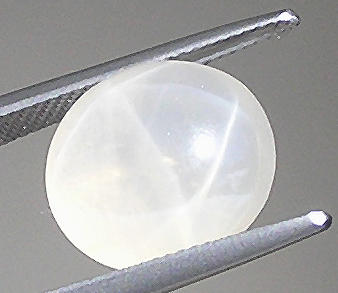 Two 6-ray and one 4-ray stars are visible. For a better image, see: Star Quartz. Photo: E. Skalwold | ||
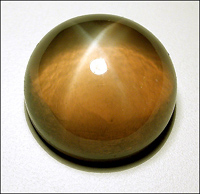 Photo: Rick Martin, Art Cut Gems |
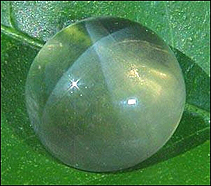 Photo: Rick Martin, Art Cut Gems | ||
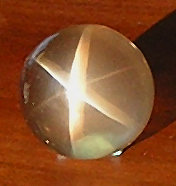 Specimen courtesy of Rick Martin, Art Cut Gems. Photo: E. Skalwold |
The star quartz pictured above is interesting in that it displays one very strong ray, a weaker ray and a third ray visible only in strong light, forming the 6-ray star seen at left. In transmitted light, all three rays are visible in an effect known as diasterism (see below). There are very fine, barely eye-visible golden needles which are responsible for the chatoyant bands. A very similar material was reported by J. Bradshaw, a curator of the Harvard gem collection, in G&G Fall 1987 as being from Belle Horizonte, Minas Gerias. Investigations conducted by Dr. Lore Kiefert on similar quartz stars and using EDXRF spectroscopy, concluded that the needles were most likely rutile based on the detection of titanium (the needles were too fine for Raman). After examining this star stone with advanced instrumentation, rutile is most likely also the case here (more). | ||
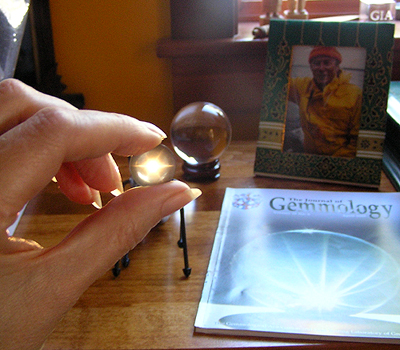 Specimen courtesy of Rick Martin, Art Cut Gems. Photo: E.Skalwold | |||
| As with the star quartz reported by Dr. Kiefert, the needles in this quartz are oriented in three sets in a plane perpendicular to the c-axis with additional needles oriented at an angle. The density of the needles in each of the sets is not the same, being more densely packed in one direction than another. This probably accounts for the difference in strength of the three chatoyant bands. A similar situation was observed in a chatoyant quartz from India and reported in detail by Gagan Choudhary (2009). As can be seen in the view below of the most congested direction, the orientation of some needles is being dictated differently than that of others. | |||
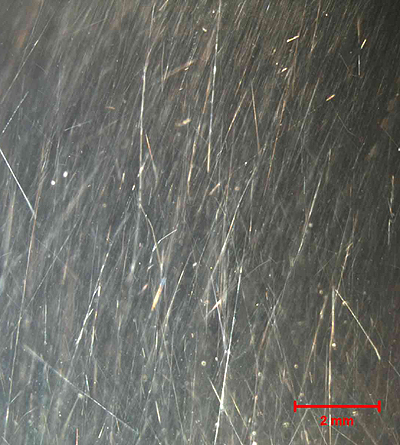 Needles seen in the star smokey quartz seen at left above. (more on microscopy) Photo: E.Skalwold | |||
| |||
|
| |||